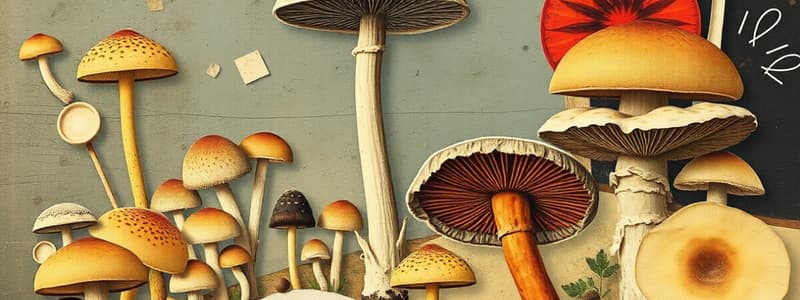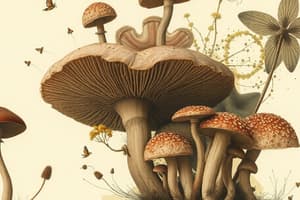Podcast
Questions and Answers
What is the primary result of karyogamy in sexual reproduction?
What is the primary result of karyogamy in sexual reproduction?
- Initiation of the haploid phase
- Formation of haploid cells
- Creation of meiospores
- Formation of a diploid nucleus (correct)
Which phylum is characterized by the presence of male and female sex organs called antheridia and oogonia respectively?
Which phylum is characterized by the presence of male and female sex organs called antheridia and oogonia respectively?
- Phylum Zygomycota
- Phylum Oomycota (correct)
- Phylum Basidiomycota
- Phylum Ascomycota
In which phylum does gametangia conjugation occur?
In which phylum does gametangia conjugation occur?
- Phylum Basidiomycota
- Phylum Zygomycota (correct)
- Phylum Oomycota
- Phylum Ascomycota
What distinguishes classification from taxonomy?
What distinguishes classification from taxonomy?
What type of fungi are responsible for decomposing organic matter?
What type of fungi are responsible for decomposing organic matter?
What constitutes the primary structure of fungal cell walls?
What constitutes the primary structure of fungal cell walls?
Which of the following taxonomic ranks comes immediately after Phylum in fungal nomenclature?
Which of the following taxonomic ranks comes immediately after Phylum in fungal nomenclature?
Which statement accurately reflects the classification of fungi?
Which statement accurately reflects the classification of fungi?
Which level of biodiversity encompasses genetic diversity within a species?
Which level of biodiversity encompasses genetic diversity within a species?
What is the primary purpose of nomenclature in fungi?
What is the primary purpose of nomenclature in fungi?
What type of diversity refers to the differences within and between populations of species?
What type of diversity refers to the differences within and between populations of species?
How many phyla is the kingdom Fungi divided into?
How many phyla is the kingdom Fungi divided into?
Which of the following correctly identifies a component of ecosystem diversity?
Which of the following correctly identifies a component of ecosystem diversity?
What is the basic unit of life in the study of biology?
What is the basic unit of life in the study of biology?
Which of the following best describes fungi in terms of their cellular structure?
Which of the following best describes fungi in terms of their cellular structure?
How do hyphae contribute to fungal growth?
How do hyphae contribute to fungal growth?
Which of the following processes occurs during asexual reproduction in fungi?
Which of the following processes occurs during asexual reproduction in fungi?
What do fungi secrete to aid in their absorption of nutrients?
What do fungi secrete to aid in their absorption of nutrients?
What type of spores are produced by mitotic processes in fungi?
What type of spores are produced by mitotic processes in fungi?
In the context of fungi, what is a mycelium?
In the context of fungi, what is a mycelium?
What is the primary mode by which yeast cells reproduce?
What is the primary mode by which yeast cells reproduce?
Which statement about the cellular structure of fungi is incorrect?
Which statement about the cellular structure of fungi is incorrect?
What does plasmogamy refer to in the fungal reproduction process?
What does plasmogamy refer to in the fungal reproduction process?
Which kingdom includes organisms with well-defined tissue systems and maximum morphological capacities?
Which kingdom includes organisms with well-defined tissue systems and maximum morphological capacities?
What is the primary characteristic of organisms in Kingdom Protista?
What is the primary characteristic of organisms in Kingdom Protista?
Which of the following statements accurately describes fungi?
Which of the following statements accurately describes fungi?
Which group of organisms falls under the category of lower protists in Copeland's concept?
Which group of organisms falls under the category of lower protists in Copeland's concept?
Which of the following is a characteristic of Chromistan Fungi?
Which of the following is a characteristic of Chromistan Fungi?
In which taxonomy system are organisms grouped solely based on cellular structure and nutritional modes?
In which taxonomy system are organisms grouped solely based on cellular structure and nutritional modes?
What does the term 'osmotrophic' imply about fungi?
What does the term 'osmotrophic' imply about fungi?
Which kingdom is specifically known for including only purely autotrophic organisms?
Which kingdom is specifically known for including only purely autotrophic organisms?
The grouping of Bacteria, Algae, and Fungi falls under which taxonomy classification?
The grouping of Bacteria, Algae, and Fungi falls under which taxonomy classification?
Which of the following is NOT a feature of fungi as described in taxonomy?
Which of the following is NOT a feature of fungi as described in taxonomy?
Flashcards
Karyogamy
Karyogamy
The fusion of two haploid nuclei to form a diploid nucleus.
Meiosis
Meiosis
A type of cell division that reduces the chromosome number to half, producing haploid gametes.
Fungal Nutrition
Fungal Nutrition
Fungi can be saprophytic (feeding on dead matter), parasitic (feeding on living organisms), or symbiotic (living in a beneficial relationship with other organisms).
Gametangia
Gametangia
Signup and view all the flashcards
Classification vs. Taxonomy
Classification vs. Taxonomy
Signup and view all the flashcards
Fungi Taxonomy
Fungi Taxonomy
Signup and view all the flashcards
Eukaryotic Fungi
Eukaryotic Fungi
Signup and view all the flashcards
Hyphae
Hyphae
Signup and view all the flashcards
Mycelium
Mycelium
Signup and view all the flashcards
Yeast
Yeast
Signup and view all the flashcards
Heterotrophic
Heterotrophic
Signup and view all the flashcards
Asexual Reproduction
Asexual Reproduction
Signup and view all the flashcards
Spores
Spores
Signup and view all the flashcards
Mycology
Mycology
Signup and view all the flashcards
Plasmogamy
Plasmogamy
Signup and view all the flashcards
Fungi Diversity
Fungi Diversity
Signup and view all the flashcards
Fungal Phyla
Fungal Phyla
Signup and view all the flashcards
Fungal Nomenclature
Fungal Nomenclature
Signup and view all the flashcards
Biodiversity Levels
Biodiversity Levels
Signup and view all the flashcards
Fungal Taxonomy
Fungal Taxonomy
Signup and view all the flashcards
Fungi Evolution
Fungi Evolution
Signup and view all the flashcards
Fungal Classification
Fungal Classification
Signup and view all the flashcards
Biodiversity of Fungi
Biodiversity of Fungi
Signup and view all the flashcards
Two Kingdom System
Two Kingdom System
Signup and view all the flashcards
Three Kingdom System
Three Kingdom System
Signup and view all the flashcards
Four Kingdom system
Four Kingdom system
Signup and view all the flashcards
Five Kingdom System
Five Kingdom System
Signup and view all the flashcards
Fungal Definition
Fungal Definition
Signup and view all the flashcards
Eukaryotic
Eukaryotic
Signup and view all the flashcards
Heterotrophic
Heterotrophic
Signup and view all the flashcards
Osmotrophic
Osmotrophic
Signup and view all the flashcards
Hyphae
Hyphae
Signup and view all the flashcards
Taxonomy of Fungi
Taxonomy of Fungi
Signup and view all the flashcards
Study Notes
Course Information
- Course title: Taxonomy & Biodiversity of Fungi (MICR 331)
- Professor: Sherif Zaki
- Credit hours: 3 credit hours
- 2 hours lecture weekly
- 2 hours practical weekly
- Evaluation:
- Written Exam: 90 marks
- Practical Exam: 37 marks
- Oral Exam: 8 marks
- Activities: 15 marks
- Total: 150 marks
- Lecture: Tuesday 11-1, class 7
- Practical: Wednesday 1-4, lab 2
- Office hours: Online session 2 hours weekly on Microsoft teams: MICR 331 - 2022
- Communication: WhatsApp group: MICR 331 – 2022 – 01115926664
- Activities: LMS (Learning Management System)
Objectives
- Learning and mastering the basics of fungal taxonomy
- Recognizing the characteristics of taxonomic groups of fungi
- Realizing fungal biodiversity
- Differentiating between different groups of fungi
What are Fungi?
- Biology is the study of life and living organisms
- The cell is the basic unit of life
- Gene is the basic unit of heredity
- Evolution is the engine propelling species creation and extinction
- Living organisms are categorized as plants, animals, and microorganisms
- Microbiology is a branch of biology concerned with the study of microorganisms
- Unicellular
- Multicellular
- Acellular
- Sub-disciplines including Virology, Bacteriology, Mycology, Immunology, Parasitology
Fungal Body
- Multicellular thallus
- Tubular filaments = hyphae
- Hyphal network = mycelium
- Unicellular thallus
- Called "yeast"
- Unicellular cells
- Multiply by budding
Fungal Growth
- Spores germinate
- Hyphae grow from their apical zone
- Form hyphal network (mycelium)
- Secrete enzymes which degrade organic compounds
- Absorption of simpler organic compounds through hyphal wall
- Enter reproductive phase
Asexual Reproduction
- Fission
- Budding
- Fragmentation
- Spore production (mitospores)
- Blastospores
- Arthrospores
- Sporangiospores
- Conidiospores
- Chlamydospores
Sexual Reproduction
- Plasmogamy (fusion of two protoplasts)
- Bringing two compatible haploid nuclei together
- Karyogamy (fusion of haploid nuclei)
- Formation of a diploid nucleus
- Produces a Zygot
- Meiosis (restoring haploid number of chromosomes)
- Initiates haploid phase
- Produces gametes
- Meiospores
Phylum Oomycota
- Male sex organ (antheridia)
- Female sex organ (oogonia)
Phylum Zygomycota
- Gametangia conjugation (+gametangia + gametangia)
Phylum Ascomycota
- Fusion of two compatible nuclei
- Spore
Phylum Basidiomycota
- Fusion of two compatible nuclei
- Spore
Fungal Nutrition
- Saprophytic fungi
- Obtain food from dead organic material
- Responsible for decomposing organic matter
- Parasitic fungi
- Attack living organisms
- Penetrate defenses
- Obtain nourishment from living cytoplasm
- May cause disease or death in the host organism
- Symbiotic fungi
- Lichens
- Mycorrhiza
Nomenclature of Fungi
- Nomenclature includes rules for establishing a name, determining if it is correct, and creating standards for application of names
- Formal rules for naming fungi and fungi-like organisms found in the International Code of Nomenclature for algae, fungi, and plants (ICN)
Taxonomic Ranks
- Phylum: -mycota
- Subphylum: -mycotina
- Class: -mycetes
- Order: -ales
- Family: -aceae
- Genus Species
Species and Generic Concepts
- Species is the basic unit of taxonomy and a result of evolution from reproductive isolation
- Phenotype species concept = Individuals agree morphologically
- Chemotaxonomic concept = Individuals agree physiologically or chemically
- Biological species concept = Individuals agree genetically by compatibility
- Phylogenetic species concept = Individuals agree at the DNA level
- Generic concept of species = smallest aggregation of populations diagnoses by a unique combination of character states in comparable individuals
Biodiversity of Fungi
- Some fungi can produce motile cells
- Others never produce motile cells
Studying That Suits You
Use AI to generate personalized quizzes and flashcards to suit your learning preferences.




